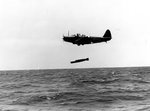oldcrowcv63
Tech Sergeant
Didn't the torpedos have to travel some distance in the water before they armed ?
Yes, I am pretty sure there was a minimum run time necessary to arm. That "omitting the water part" doesn't seem quite right. All the attempts to launch aerial torpedoes as well as the sub launched opportunities were essentially a bust with, as Bjoint says, the PBY's night attack (1 out of 4 tries) about the only success experienced. Let's see, PBY's (1 for 4), subs (0 for 2?), aircraft (0 for 51). That's a total of 1 for 57? Geez! US torpedoes make B-17s look like sharpshooters when it comes to anti-shipping! To call a US Torpedo an anti-shipping weapon is an insult to weapons and maybe ships too.
On the other hand with all those torpedoes in the water one can see why the IJN was maneuvering like crazy and couldn't steady up into the wind until the attacks were over.
Last edited:

